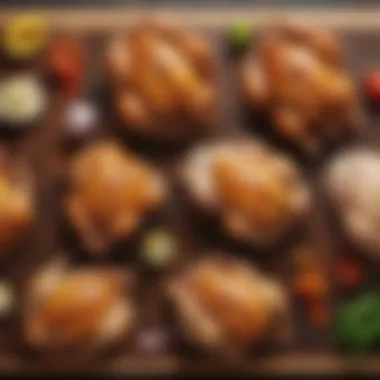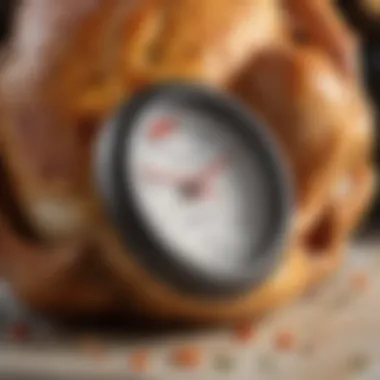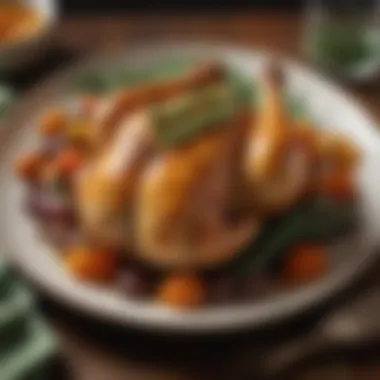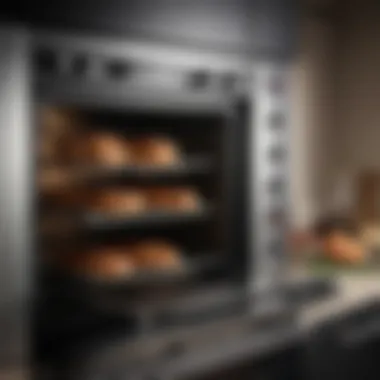Mastering Chicken Baking Times for Perfect Results


Intro
Cooking chicken effectively can transform it into a culinary delight. Understanding optimal baking times is essential for achieving the best flavor, texture, and juiciness. There are several variables to consider that can significantly affect cooking times. Factors such as the type of chicken, the weight, and the cooking temperature play crucial roles.
This guide will discuss these variables in detail to enable home cooks to achieve consistent results in baking chicken. It aims to inform culinary enthusiasts, whether beginners or seasoned cooks, about best practices for cooking this popular protein.
Recipe Overview
Perfectly Baked Chicken
- Portions: Serves 4
- Total Time: 15 minutes prep time, 1 hour cooking time
- Difficulty: Easy
- Ingredients:
- Whole chicken or individual cuts (breast, thighs)
- Olive oil
- Salt
- Pepper
- Any preferred spices or herbs (e.g., garlic powder, paprika)
Key Points to Discuss
- Importance of understanding the various baking times based on chicken weight.
- Discussing recommended cooking temperatures.
- Providing time management suggestions for busy cooks.
Step-by-Step Instructions
- Prepping the Chicken:
- Seasoning:
- Preheating the Oven:
- Baking:
- If using a whole chicken, remove any giblets from the cavity. Rinse and pat dry with paper towels.
- For cut pieces, ensure they are evenly sized for uniform cooking.
- Coat the chicken with olive oil. This helps achieve a crispy and golden-brown skin.
- Generously sprinkle salt and pepper, or any preferred seasoning mixture. Ensure coverage on all surfaces.
- Preheat your oven to either 375°F or 400°F based on the chosen cooking method. Higher temperatures yield more browning.
- Place the seasoned chicken in a roasting pan, skin side up. The pan allows for even heat distribution.
- Bake uncovered. For whole chicken, approximately 20 minutes per pound is a common metric. Check using a meat thermometer. Chicken is safe at 165°F internally.
Time-Saving Strategies
- Utilizing a convection oven can reduce baking time due to better air circulation.
- Prepping chicken in advance can cut down on preparation time ahead of serving.
Nutritional Information
- Total calories per portion: 350 calories
- Macronutrients:
- Protein: 30g
- Fat: 22g
- Carbohydrates: 0g
Beneficial nutrients in baked chicken include:
- Selenium, which supports metabolism and thyroid function.
- Niacin, important for nerve function and energy production.
Quick Cooking Tips
- Try cooking chicken in an air fryer for crispiness without the excess oil.
- Multitask by preparing side dishes while the chicken bakes to decrease total cooking time.
Healthier Alternatives
- Consider skinless chicken for reduced calorie content.
- Replace regular olive oil with cooking spray for lower fat usage.
Related Recipes & Variations
- Roasted Vegetables: A great side dish that cooks well at similar temperatures.
- Scrumptious BBQ Chicken: Marinate for different flavor.
Adaptations for Dietary Needs:
- Use gluten-free spices or sauces as applicable for sensitive diners.


Culinary enthusiasts may explore variations based on personal preference or dietary restrictions. Sharing unique adaptations in forums like Reddit can also yield inspiration from others.
Remember, mastering baking times broadens your culinary repertoire, infusing your cuisine with diverse flavors and options.
Understanding the Basics of Baking Chicken
Baking chicken is a fundamental cooking technique, adequate understanding is essential for either amateur cooks or seasoned chefs. This effective method results in tender, juicy meat when managed skillfully. Proper knowledge enhances not only flavors but also promotes food safety and efficient preparation, converging culinary art with practical utility.
Types of Chicken Cuts and Their Characteristics
In the culinary realm, chicken is available in various cuts, each bearing its own unique qualities. The distinction between these cuts influences baking times and methods. Here are some notable examples:
- Whole Chicken: This is often the centerpiece of many dishes. Whole chickens require longer cooking times but yield richer flavors.
- Breasts: Chicken breasts are the leanest cut and are most prized for their health benefits. They tend to dry out quickly if overcooked.
- Thighs: Known for their darker meat flavor, thighs are also slightly more forgiving during cooking, remaining moist even if slightly overbaked.
- Drumsticks: Similar to thighs, drumsticks provide rich taste and texture. They require a longer cooking time than breasts due to denser meat.
- Wings: Often cooked for appetizers, wings are small and quick to bake. Seasoning varies widely from simple to complex flavors.
Understanding these cuts is integral. It helps in deciding appropriate baking methods and knowing how long to bake particular styles.
Essential Baking Equipment and Tools
To achieve optimal baking results with chicken, certain equipment and tools are indispensable. They ensure accuracy, enhances efficiency, and save time. First, an oven that can consistently maintain heat plays a critical role. Beyond basic functionality, the following items optimize the cooking process:
- Baking Sheet or Roasting Pan: A flat surface is required to evenly arrange chicken, allowing for optimal air circulation.
- Meat Thermometer: This is perhaps the most crucial tool. It assists in checking chicken doneness without guesswork.
- Cooking Spray or Oil: This aids in preventing chicken from sticking, achieving golden-brown skin.
- Aluminum Foil: Useful for covering chicken in the first part of baking, preventing premature browning.
- Basting Brush: Utilizing a brush aids in evenly applying marinades or oils.
Equipping yourself with these tools streamlines the baking process. This attention to details elevates the overall meal experience.”
Factors Influencing Baking Time
Understanding the various factors that affect baking time is crucial for achieving the best results when cooking chicken. Different elements can change how long chicken requires in the oven. From its weight to the cooking method employed, several conditions impact the outcome of your dish. Recognizing these variables not only helps in meal planning but also allows for experimentation within one’s culinary practice.
Weight and Size of the Chicken
The chicken's weight and size significantly determine the baking time required. Generally, larger pieces need more time to cook thoroughly compared to smaller ones. Notably, a whole chicken takes an extended duration compared to chicken breasts. On average, a standard roasting weight recommendation for a whole chicken is about 20 minutes per pound at 350°F. Conversely, chicken breasts or thighs might take 25 to 30 minutes per pound. Proper awareness of size allows for accurate timing, reducing the risk of undercooking or overcooking which can spoil the dish's safety and flavor.
Baking Temperature Variations
The temperature at which you bake chicken greatly influences how long it will take to cook properly. A common suggestion is to set your oven to around 375°F for uniform cooking. Higher temperatures, like 425°F, may rates quicker cooking but necessitate careful monitoring to avoid drying out the meat. Lower settings often produce tender chicken but require extra time to ensure doneness. Thus, selecting the right temperature based on the chosen chicken cut can yield advantageous results.
Using appropriate temperatures can enhance taste while achieving the desired texture in your baked chicken.
Bone-In Versus Boneless Chicken
When determining baking time, it’s pivotal to consider whether you are working with bone-in or boneless chicken. Bone-in cuts retain heat differently than boneless options, necessitating longer baking times for the former. For instance, bone-in breasts do not cook as quickly as boneless breasts. A typical recommendation holds that bone-in pieces should add about 15 min requires compared to boneless. Therefore, opting for specific cuts can impact not just the flavor but the overall timing of your dish.
Fresh Versus Frozen Chicken
Frozen chicken often requires adjustments to baking times. While fresh chicken can be prepared straightforwardly, frozen variants might improve both the cooking time and meat texture by ensuring even cooking, but you must account for the initial thawing phase. It is essential to plan for this when figuring cooking schedules. In practice, assume that baking frozen chicken may extend time by 50% as compared to fresh alternatives. Understanding this distinction proves beneficial for meal preparation, guiding one to achieve precisely cooked chicken, enhancing overall satisfaction.
General Guidelines for Baking Chicken
The process of baking chicken can appear simple, yet it involves several nuances that can influence the overall outcome. Establishing general guidelines is crucial, as it helps in coordinating efforts in the kitchen while ensuring the chicken is cooked safely and tastily. These guidelines provide a structure that aligns cooking techniques with specific parameters, leading to more consistent results. By understanding the general rules for baking chicken, culinary enthusiasts can optimize their approach, refining both flavor and texture across different cuts.
Standard Baking Times for Different Cuts
When it comes to baking chicken, the cut is perhaps the single most important factor affecting cooking time. Each cut has its own set of characteristics, influencing how long it should be cooked. Here are standard baking times for various cuts:
- Whole Chicken: Baking typically takes around 1.5 to 2 hours at 350°F (175°C).
- Chicken Breasts: Generally, these require 20 to 30 minutes, depending on thickness and whether they are boneless or bone-in.
- Chicken Thighs: Expect to bake thighs for approximately 35 to 45 minutes. Bone-in pieces may take a bit longer due to their denser structure.
- Drumsticks: These should bake for around 30 to 40 minutes.
- Chicken Wings: A duration of 25 to 35 minutes is typically suitable.
It's important to note that these are only guidelines. Variations in weight and temperature can affect the final baking time. Always adjust while keeping an eye on those specifics.
Using a Meat Thermometer Effectively
Using a meat thermometer on baked chicken is a fundamental practice for ensuring proper doneness. Chicken should reach an internal temperature of 165°F (74°C) to be considered safe to consume. A meat thermometer provides an immediate reading that informs cooks if more time is needed.


When checking temperature, insert the probe into the thickest part, avoiding bones for an accurate read. If preparing a whole chicken, check at the juncture of the thigh and body, while for chicken breasts, target the thickest section.
The thermometer-shaped equipment can also assist in avoiding overcooking. Since chicken continues to cook after removal from the oven, undetected heat can lead to dry meat. Thus, it’s advisable to remove the chicken from the oven once it attains a temperature of about 160°F (71°C), allowing it to rest as it reaches the recommended 165°F.
Resting Time After Baking
Resting baked chicken is a vital step that is often overlooked. After the chicken comes out of the oven, letting it sit for around 5 to 10 minutes is beneficial. This period allows juices, which may migrate toward the center during cooking, to redistribute throughout the meat.
If not allowed to rest, juices can pour out when you cut into the chicken, resulting in dry meat. Resting keeps the chicken moist and enhances the overall eating experience. It also gives one a chance to prepare sides or plating while chicken settles for that ideal serving.
“Baking chicken is not just about time; it's about process and considering how elements like resting can enhance the final product.”
By keeping these guidelines in mind, cooking chicken can transition from merely acceptable to simply excellent. While adhering to these principles greatly improves outcomes in flavor and tenderness, embracing personal preferences over time can drive an even deeper mastery of chicken baking in the kitchen.
Baking Chicken by Specific Type
Baking chicken effectively involves understanding the nuances associated with different chicken types. It's not just about sticking it in the oven; various cuts display diverse characteristics that dictate their optimal baking times and techniques. Recognizing the specific elements of each type comes with benefits. For instance, cooking a whole chicken distinctively requires thorough heat penetration compared to smaller pieces like wings. This section aims to clarify the required methods and practices for laying down ideal baking results based on chicken cuts.
Baking Whole Chicken
Baking a whole chicken requires attention to factors such as size and cooking time to ensure even doneness. The average baking time for a whole chicken is typically 20 minutes per pound at a temperature of 375°F (190°C). To get the best results, remove giblets and pat the chicken dry. Position it breast side up in the oven to facilitate optimal heat circulation. Roasting at a steady temperature enhances the chicken's natural juicy flavors while maintaining a crisp skin that everyone enjoys.
Tip: If you want extra flavor, consider rubbing seasonings under the skin before baking. This technique helps infuse aromatic components throughout the meat rather efficiently.
Baking Chicken Breasts
Chicken breasts are popular for their lean quality, making them a go-to in many households. Because they are typically boneless and skinless, they need less cooking time compared to other cuts. Generally, bake chicken breasts for 20 to 30 minutes while ensuring a 165°F (74°C) internal temperature is reached. Choosing the right baking dish is also essential; a shallow pan can speed up the cooking process while helping to maintain moisture.
Remember, overcooking chicken breasts can quickly lead to dry meat. To mitigate this risk, you may want to marinate beforehand or brine the pieces for enhanced moisture retention.
Baking Chicken Thighs and Drumsticks
Chicken thighs and drumsticks benefit from slightly longer baking times due to their higher fat content and bone composition. These cuts are generally best baked at 375°F (190°C) for about 35 to 45 minutes. This method ensures not only that the meat becomes tender but that the skin comes out crispy. The presence of bones does not detract from cooking speed; rather, it assists in even cooking, as bones provide additional flavor.
For even more flavor, consider separating the skin and the meat slightly when applying spices. This allows seasonings to soak in better, elevating the overall taste of the finished product.
Baking Chicken Wings
Chicken wings can vary significantly in size and require different consideration based on whether they are whole or separated. Baking wings typically requires about 40 to 45 minutes at 400°F (200°C). Higher temperatures help achieve the crispiness wings are known for. It is vital to cook wings until they are fully done, reaching a minimum temperature of 165°F (74°C) internally.
"Understanding the unique characteristics of each chicken cut expands your baking horizons and ensures delicious results every time."
Common Mistakes in Baking Chicken
Baking chicken is an intricate process that requires attention to detail. A simple mistake can cause the cooking process to falter, leading to dry, bland, or improperly cooked meat. Understanding common errors helps enhance your overall result. When you master these aspects, you increase your chances of capturing the flavors and textures that define perfectly baked chicken.
Improper Temperature Settings
One of the major mistakes is not setting the oven to the correct temperature. Using too high or too low temperatures leads to either burned surfaces or undercooked meat inside, both undesirable outcomes. Different chicken cuts require specific temperatures. For instance, a whole chicken benefits from a balance of heat, often around 375°F, while chicken breasts can often cook well around 400°F.
To achieve optimal results:
- Use an oven thermometer to ensure accurate temperature readings.
- Remember that each oven heats differently. Observe how your own breeds cook over time.
- Avoid overcrowding. This may affect air circulation, causing uneven cooking.
Neglecting to Preheat the Oven
Preheating the oven is often overlooked, yet this step plays an essential role. When you neglect this detail, you may start cooking chicken at an incorrect temperature. This could delay the baking time and not allow poultry to hit its target temperature efficiently.
Preheating ensures:
- Uniform cooking from the outset.
- Retention of moisture in the meat, preventing dryness.
- Development of flavor through the Maillard reaction.


+a simple preheat can improve overall cooking outcomes. Make it a habit to preheat your oven before placing the chicken inside.
Skipping the Marinade
Marinating chicken is an effective technique to enhance both tenderness and flavor. Skipping this step often leads to bland meat lacking the desired depth of taste. Simple marinades can elevate the dish to a whole new level.
Consider:
- Ingredients: Use oil, acid like vinegar or lemon, along with herbs and spices.
- Time: Allow the chicken to rest a few hours or overnight in the mixture for better absorption.
- Texture: A good marinade not only improves taste but also helps to tenderize tougher cuts.
Enhancing Flavor in Baked Chicken
Adding flavor to baked chicken is an art that transforms a simple meal into a culinary delight. The way we enhance the natural taste of chicken influences not just the eating experience but also the overall satisfaction of cooking it. Flavor enhancement can significantly improve dishes, adding depth and character, enticing even the most discerning palates.
In this section, we explore two main methods: marinades and seasonings, as well as stuffing and basting techniques. Understanding these processes can make a considerable difference in texture and taste of the chicken.
Marinades and Seasonings
Marinades play a significant role in improving the flavor of chicken. By immersing the meat in a flavor-packed mixture prior to baking, we allow for the infusion of seasonings, acids, and oils. The primary components of marinades typically include:
- Acidic elements: These can be lemon juice, vinegar, or yogurt. They help to tenderize the meat while adding brightness to the flavor.
- Oils: Often used to add richness and carry the flavor of herbs and spices into the chicken.
- Spices and herbs: Garlic, rosemary, cumin, or paprika are just a few options that can contribute diverse flavors.
Marinating chicken for at least 30 minutes can make a difference. For deeper flavor penetration, consider marinating involved chicken cuts for several hours, or overnight when possible. It ensures the chicken is tender and packed with taste at every bite. Here are some popular marinade ideas you could try:
- Citrus Marinade: Combine lemon juice, olive oil, and herbs like thyme or oregano for freshness.
- BBQ Marinade: A mix of barbecue sauce, honey, and a bit of mustard can create a sweet and smoky finish.
Beyond marinades, effective seasoning before baking is vital. Seasoning is including salt, pepper, and a variety of spices to enhance the chicken's innate flavor. Aim to season liberally, especially with salt, as it opens up flavor profiles significantly. Always taste the seasoning mix before applying it, ensuring no overpowering elements exist.
“A well-marinated and properly seasoned chicken develops layers of flavor that elevate your meal experience.”
Stuffing and Basting Techniques
Stuffing chicken is tactically advantageous, providing flavorful benefits from the inside. When stuffed we can use ingredients like fruits, vegetables, or even grains to amplify taste. For instance, a stuffing made from wild rice and cranberries can offer a delightful contrast to roasted chicken.
Key stuffing ideas can be:
- A mix of bread crumbs, herbs, and diced vegetables.
- Sausage and kale, for a hearty filling.
- Quinoa mixed with nuts, dried fruits, or zesty spices can offer a nutritious and tasty stuffing.
While cooking, basting is a technique worth utilizing. This involves keeping the chicken moistened by spooning or brushing its juices back onto the meat during baking. Basting adds flavor and creates a lovely glazing effect, ensuring the chicken remains juicy. Consider utilizing any marinade or additional seasonings during the basting process for extra flavor.
Through integrating different marinades and spices, alongside a thoughtful approach to stuffing and basting, chicken flavor can significantly improve. Furthermore, adopting these techniques allows culinary enthusiasts to expand their cooking skills and deliver impressively flavored dishes.
Ending
Baking chicken seems simple, yet several factors can influence the-specific times needed to achieve perfect results. As explored in this article, an understanding of chicken types, weights, and appropriate baking temperatures is crucial. These elements not only contribute to cooking times but also play a significant role in ensuring safety and flavor preservation. Addressing these insights allows cooks, whether professionals or enthusiasts, to produce successfully baked chicken regardless of style or presentation.
Recognizing the importance of this concluding section brings forth essential considerations such as meal planning convenience, a thoughtful approach to preparation, and overall satisfaction. Efficient baking practices can save time while enhancing the cooking experience, contributing to nutritional benefits and taste aversion. Delving into the right baking times means taking steps toward mastering your kitchen practices. These extra considerations elevate meal occasions, letting you enjoy the process and share happier dining moments with loved ones.
"An informed cook is often a more efficient cook."
Notably, exploring different methods and variables brings out creativity in the kitchen. From experimenting with diverse cuts of chicken to testing out various baking temperatures, this comprehensive guide serves as a reference for anyone keen to sharpen their culinary skills. The favorable outcomes of these repeated trials reinforce the relevance of the practices and principles discussed here, making each baking task a rewarding endeavor.
Recap of Key Points
- Types of Chicken Cuts: Different cuts influence cooking efficiency and time.
- Weight and Size: Heavier or larger pieces require more time at a consistent temperature.
- Baking Temperatures: Adjustments based on temperature impact the final doneness and texture.
- Monitoring with a Thermometer: A key tool to avoid overcooking or undercooking chicken.
Understanding the significance of time while baking chicken covers both safety and enjoyment aspects. Proper knowledge on such matters empowers cooks, making for better results and appreciated meals.
Final Thoughts on Effective Baking
Effective baking is a blend of timing, attention, and method. Take into account the chicken cut, its weight, and baking temperature sweetheart into the invitation to a beautifully completed dish. Fostering these qualities predicts belonging results, enhancing the aroma encountered as it slowly emerges from the oven.
Additionally, engaging in practices like preheating the oven, adequate marination, and utilizing the right tools will provide an ensured outcome.
Emphasis on continuing education in baking methods, recipes, and tools help strengthen proficiency. By gleefully refining techniques over time, every batch baked becomes another learning experience, warmly inviting culinary adventure each time.
Overall, maintaining informed decisions about baking chicken can convert a simple recipe into a superior meal. Incorporating what was discussed, your investment in optimal practices stands as a testimony to capable cooking. Not only do you need patience, determination, knowledge basculist pigeon but every bite will reflect your growing passion in the kitchen.







